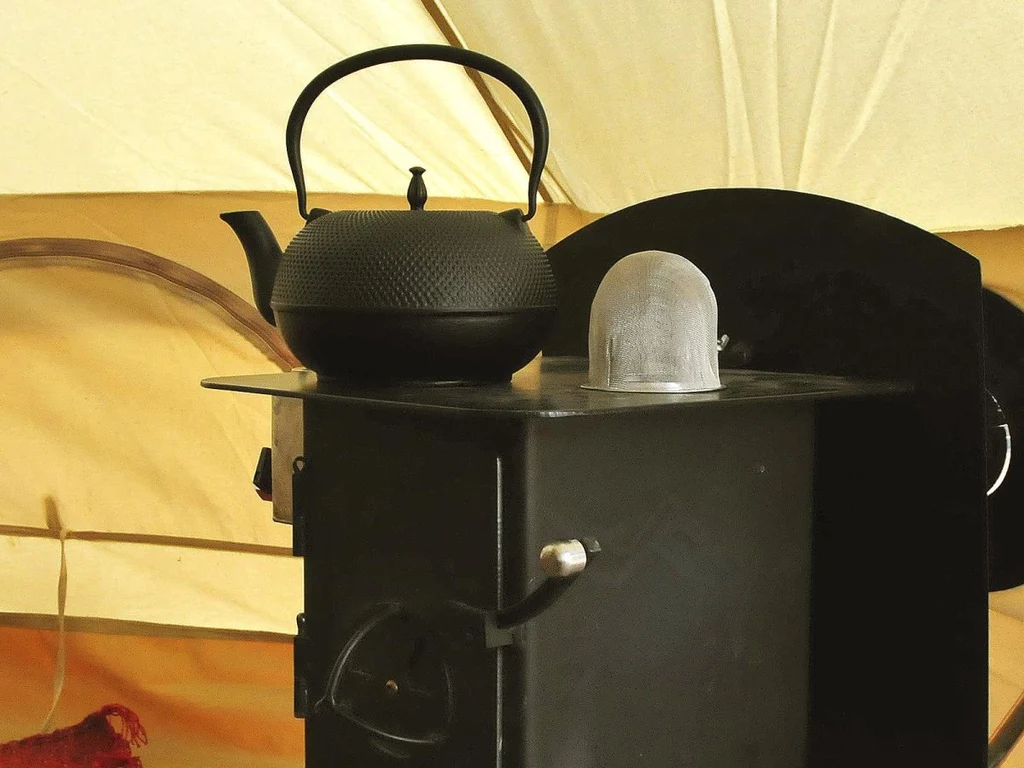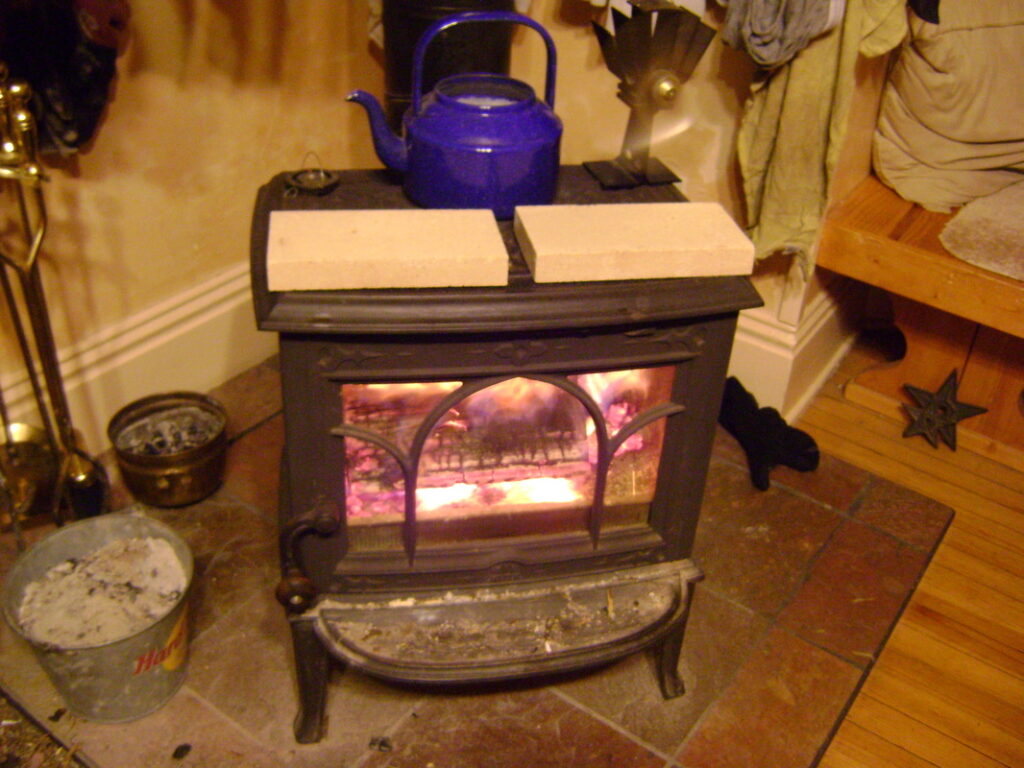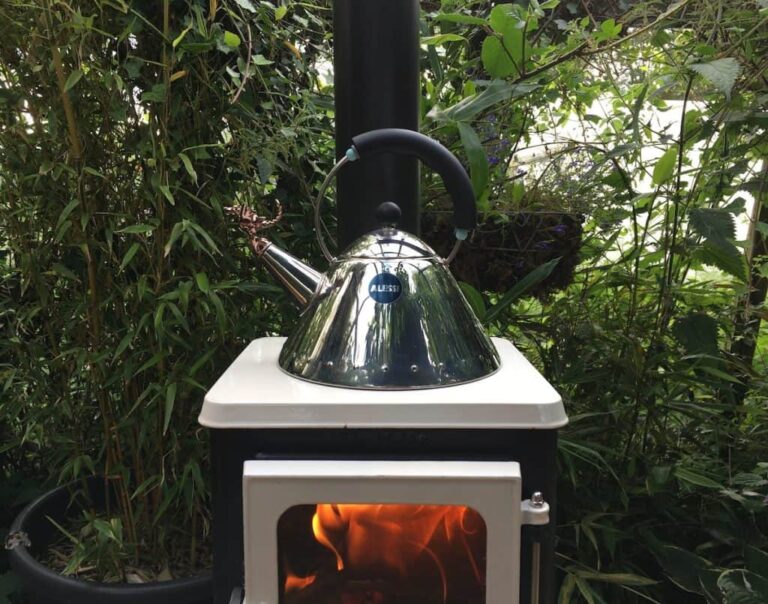Yes, you can put a kettle on your wood burner! It’s a cozy and practical way to heat water. The heat from the wood burner efficiently warms the kettle, making it an eco-friendly choice. To do this safely, choose a kettle with heat-resistant handles and avoid leaving it unattended. Ensure the wood burner is stable, and the kettle is positioned securely.
Once heated, you can enjoy a warm cup of tea or coffee. It’s a simple and charming method, perfect for those chilly evenings by the fire. Just remember to prioritize safety and choose the right kettle for the job!
What are the benefits of using a kettle on a wood burner?

Using a kettle on a wood burner presents various benefits that extend beyond the mere practicality of heating water.
Energy Efficiency: The wood burner generates ample heat, providing an energy-efficient way to heat water for your beverages. By leveraging the existing heat source, you reduce the need for additional energy consumption, potentially leading to cost savings on utility bills.
Environmental Friendliness: Harnessing the power of a wood burner aligns with environmentally conscious practices. Wood is a renewable resource, and utilizing it for both heating and water boiling contributes to a sustainable and eco-friendly lifestyle.
Atmospheric Ambiance: The crackling warmth of a wood burner adds a unique and cozy ambiance to your surroundings. Boiling a kettle on the wood burner enhances this atmospheric experience, making your tea or coffee preparation more enjoyable and comforting.
Cost Savings: With a wood burner already in use for heating, incorporating it into your water-boiling routine can lead to cost savings. It’s a practical and economical approach to utilizing available resources effectively.
Rustic Charm: The act of boiling a kettle on a wood burner carries a rustic charm, evoking a sense of simplicity and connection to traditional living. This charming method can be particularly appealing for those who appreciate a more authentic and nostalgic lifestyle.
How can I safely use a kettle on my wood burner?
Ensuring the safe use of a kettle on your wood burner involves a combination of selecting the right kettle and following specific precautions. Here’s a step-by-step guide
- Go for a kettle with heat-resistant handles to prevent burns. Materials like stainless steel or ceramic are suitable choices.
- Place the kettle on a stable surface atop the wood burner. This helps avoid accidents and spills.
- Never leave the kettle unattended while it’s on the wood burner. Keep a watchful eye to prevent any mishaps.
- Follow the manufacturer’s guidelines regarding water capacity. Overfilling can lead to boiling water spilling, causing burns or damage.
- Keep the wood burner and surrounding area clean and free of debris. This minimizes the risk of accidents and ensures efficient heating.
- Consider using a kettle with a whistle or set a timer to alert you when the water is boiling. This helps in preventing over-boiling or the kettle drying out.
- Ensure the kettle is placed away from direct flames on the wood burner. Position it in a way that maximizes heat transfer without causing damage.
- Allow the kettle to cool down on a heat-resistant surface before handling. Avoid direct contact with hot surfaces.
- If others in your household use the wood burner, educate them on the proper use and precautions associated with boiling water on it.
- Keep a fire extinguisher nearby as a precaution. Know its location and how to use it effectively.
Types of Kettles Suitable for Wood Burners
Material Matters
Stainless Steel Kettles: These are a popular choice due to their durability and resistance to rust. Stainless steel kettles are well-suited for the heat produced by wood burners.
Ceramic Kettles: Known for their aesthetic appeal, ceramic kettles are also good heat retainers. They may take a bit longer to heat up but maintain temperature well.
Handle Considerations:
Heat-Resistant Handles: Choose kettles with handles made from heat-resistant materials. This ensures that the handle remains cool to the touch even when the water inside is boiling.
Capacity and Size:
Optimal Size: Consider the size of the kettle in relation to your wood burner. A too-small kettle may heat up too quickly, while a too-large one might be challenging to handle.
Whistling Feature:
Whistling Kettles: These have a built-in whistle that alerts you when the water is boiling. This feature is not only practical but also adds a traditional touch.
Flat Bottom vs. Rounded Bottom
Flat-Bottomed Kettles: These are more stable on the burner surface. Ensure that the bottom is flat and compatible with the shape of your wood burner.
Rounded-Bottomed Kettles: While less common, some kettles have a rounded bottom. Ensure they have a stable base to prevent tipping.
Compatibility with Induction
If your wood burner has an induction cooktop, ensure the kettle is compatible with induction heating for optimal efficiency.
Brand Recommendations:
- Le Creuset: Known for their quality ceramic kettles with vibrant colors.
- OXO: Offers stainless steel kettles with ergonomic designs and heat-resistant features.
- Chantal: Provides a variety of kettle options, including stainless steel and ceramic.
Budget-Friendly Options
- Copco: Known for affordable and durable stainless steel kettles.
- Mr. Coffee: Offers budget-friendly stainless steel and whistling kettles.
Customer Reviews:
Read customer reviews to gather insights into the performance, durability, and safety of specific kettle models. Consider feedback from users who have used them on wood burners.
Maintenance Tips
Follow manufacturer guidelines for care and maintenance to ensure the longevity of the kettle.
Regularly check for any signs of wear, especially in heat-exposed areas.
How to safely use a kettle on a wood burner? Step-by-Step Guide
Select a kettle with heat-resistant handles and a flat, stable base. Materials like stainless steel or ceramic are good choices.
Ensure the wood burner is clean and free of debris. A clean surface ensures better heat transfer to the kettle.
Fill the kettle with the desired amount of water. Avoid overfilling, as this can lead to spills and potential accidents.
Position the kettle on the flat surface of the wood burner. Ensure it’s stable and won’t tip over during heating.
If possible, position the kettle so that it receives direct heat without being in direct contact with flames. This prevents damage to the kettle.
Keep an eye on the kettle as it heats up. Avoid leaving it unattended to prevent over-boiling or dry boiling.
If your kettle has a whistle, listen for it. The whistle signals when the water is boiling, helping you avoid over-boiling.
Once the water reaches the desired temperature, turn off the wood burner. This prevents unnecessary energy consumption.
After use, let the kettle cool down on a heat-resistant surface before handling. Avoid touching hot surfaces.
Carefully pour the hot water from the kettle into your cup or teapot. Use oven mitts or a towel to handle the hot kettle safely.
Regularly clean the kettle according to the manufacturer’s instructions. This ensures proper maintenance and longevity.
What are alternatives to using a kettle on a wood burner?

While using a kettle on a wood burner is a charming and traditional way to heat water, there are alternative methods to achieve the same goal.
Electric Kettle
Quick and convenient, electric kettles heat water rapidly and often come with auto-shutoff features for safety.
Requires electricity, so it may not be suitable during power outages.
Stovetop Pot or Saucepan
Boiling water on a stovetop using a pot or saucepan is a common and versatile method.
Keep an eye on the water to avoid over-boiling, and use heat-resistant handles.
Microwave
Microwaving water is quick and efficient, making it a convenient option.
Ensure the container is microwave-safe, and be cautious as water can heat unevenly.
Coffee Maker
Some coffee makers have a hot water dispensing feature suitable for making tea or other hot beverages.
Check the manufacturer’s instructions to ensure it’s suitable for heating water.
Solar Kettle
Solar kettles use sunlight to heat water, offering an eco-friendly alternative.
Effectiveness depends on sunlight availability, making it less practical on cloudy days.
Camp Stove or Portable Burner
Portable stoves or burners provide a convenient way to heat water, ideal for camping or outdoor use.
Ensure proper ventilation, especially indoors, and follow safety guidelines.
Thermal Flask
Fill a thermal flask with hot water in advance and keep it insulated for on-demand hot water.
The initial heating process is separate, but it maintains the temperature for an extended period.
Hot Water Dispenser
Similar to electric kettles, hot water dispensers provide a constant supply of hot water on demand.
Requires a power source and may have a larger footprint compared to traditional kettles.
Gas Stove
Heating water on a gas stove is efficient and offers precise temperature control.
Ensure proper ventilation and safety measures when using a gas stove.
Instant Hot Water Taps
Installed directly in the kitchen, these taps provide instant hot water at the desired temperature.
Installation may require professional assistance, and it may consume energy continuously.
FAQ
Can you boil water on a wood burning stove?
Yes, you can boil water on a wood-burning stove. Place a kettle or suitable container on the stove’s flat surface, ensuring it’s stable and using it as an efficient method for heating water.
What not to do with a wood burner?
Avoid overloading the wood burner with excessive wood, as it can lead to overheating. Never leave it unattended while in use, and refrain from using inappropriate materials or accelerants.
Can I put water on a wood stove fire?
No, it’s not recommended to directly pour water on a wood stove fire. The sudden temperature change can damage the stove or create excess smoke. Instead, use a designated water container on the stove for heating.
What happens if water gets on the burner?
Water directly on the burner can cause cracking due to the rapid temperature change. It’s crucial to avoid spills and, if accidental, promptly clean any water that comes into contact with the hot surfaces.
What can I use to boil water on wood stove?
You can use a variety of kettles, pots, or pans with heat-resistant handles on a wood stove. Stainless steel or ceramic options work well, offering durability and efficient heat transfer.
What can I cook on top of my wood burner?
You can cook various dishes on top of a wood burner, such as soups, stews, or even simple meals in sturdy cookware. Ensure the cookware is compatible with the heat output of the stove.
Does boiling water affect wood?
Boiling water on a wood stove doesn’t directly affect the wood. However, prolonged exposure to water or moisture can impact the wood over time, potentially causing deterioration or warping.
How long does it take to boil water on a wood stove?
The time to boil water on a wood stove varies based on factors like the stove’s heat output and the amount of water. Generally, it takes around 10-20 minutes for a kettle to boil on a well-functioning wood stove.
Final thoughts
Using a kettle on your wood burner is a delightful way to warm up water for your favorite drinks. It adds a cozy feel to your routine, especially on cool nights. Just pick a kettle with safe handles, follow some simple precautions, and enjoy the soothing ambiance of a crackling fire while sipping your tea or coffee.
Whether you stick with the classic method or try alternatives, the goal is to make your experience enjoyable and secure. So, feel free to place that kettle on your wood burner and relish the warmth and homeliness it brings.

